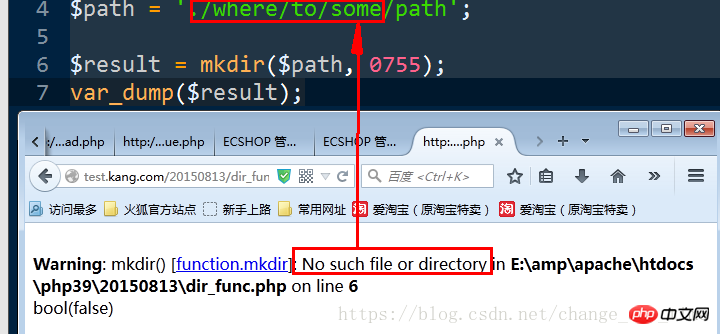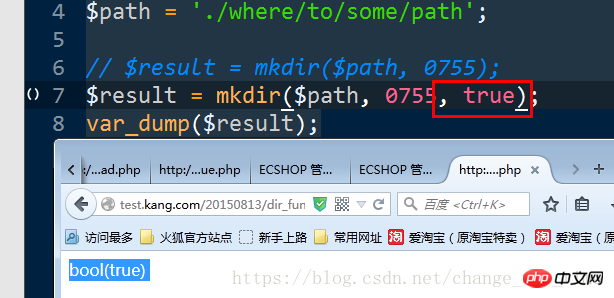How to use functions in PHP directory
This article mainly shares with you how to use the functions of the PHP directory. I hope it can help you.
Create directory
1. mkdir: Try to create a new directory specified by pathname.
bool mkdir ( string $pathname [, int $mode = 0777 [, bool $recursive = false [, resource $context ]]] )
Recursive creation is not supported by default:

The third parameter Write true:

Tip: The second one is ignored in Windows, but it is useful in Linux!
Delete directory
2. rmdir: Try to delete the directory specified by dirname. The directory must be empty and must have appropriate permissions. Failure will generate an E_WARNING level error.
bool rmdir ( string $dirname [, resource $context ] )
Tip: Deletion of non-empty directories is not allowed
Get directory contents
opendir: Open a directory handle, which can be used for subsequent closedir(), readdir() and rewinddir () is calling.
resource opendir ( string $path [, resource $context ] )
Return value: Returns the resource of the directory handle if successful, returns FALSE if failed.
readdir: Returns the file name of the next file in the directory. File names are returned in order in the file system.
string readdir ([ resource $dir_handle ] )
Parameters$dir_handle: The resource of the directory handle, previously opened by opendir()
Return value: Returns the file name on success or returns on failure FALSE
Through the handle, read a file (including files and subdirectories) from the directory, read one file at a time, and move the file pointer downward!
Note that there are
.,..virtual directories under each directory. Represents the current directory and the superior directory.
With the loop structure, you can get all the contents in the directory:

Usually ignore . and .. 
#0 file names may be treated as false, so you need to use the inequality comparison operator

closedir: Close the directory stream specified by dir_handle. The stream must have been previously opened by opendir().
void closedir ([ resource $dir_handle ] )
rename: Rename (move) a file or directory, rename oldname to newname.
bool rename ( string $oldname , string $newname [, resource $context ] )

Create directory
1. mkdir: Try to create a new directory specified by pathname.
bool mkdir ( string $pathname [, int $mode = 0777 [, bool $recursive = false [, resource $context ]]] )
Recursive creation is not supported by default:

The third parameter Write true:

Tip: The second one is ignored in Windows, but it is useful in Linux!
Delete directory
2. rmdir: Try to delete the directory specified by dirname. The directory must be empty and have appropriate permissions. Failure will generate an E_WARNING level error.
bool rmdir ( string $dirname [, resource $context ] )
Tip: Deletion of non-empty directories is not allowed
Get directory content
opendir: open a directory handle, which can be used for subsequent closedir(), readdir() and rewinddir () is calling.
resource opendir ( string $path [, resource $context ] )
Return value: Returns the resource of the directory handle if successful, returns FALSE if failed.
readdir: Returns the file name of the next file in the directory. File names are returned in order in the file system.
string readdir ([ resource $dir_handle ] )
Parameters$dir_handle: The resource of the directory handle, previously opened by opendir()
Return value: Returns the file name on success or returns on failure FALSE
#Read a file (including files and subdirectories) from the directory through the handle, read one file at a time, and move the file pointer downward!
Note that there are
.,..virtual directories under each directory. Represents the current directory and the superior directory.
With the loop structure, you can get all the contents in the directory:

通常要忽略. 和 .. 
0文件名可能被当作false 处理,所以需要使用全不等比较运算符处理

closedir :关闭由 dir_handle 指定的目录流。流必须之前被 opendir() 所打开。
void closedir ([ resource $dir_handle ] )
rename :重命名(移动)一个文件或目录,把 oldname 重命名为 newname。
bool rename ( string $oldname , string $newname [, resource $context ] )

The above is the detailed content of How to use functions in PHP directory. For more information, please follow other related articles on the PHP Chinese website!

Hot AI Tools

Undresser.AI Undress
AI-powered app for creating realistic nude photos

AI Clothes Remover
Online AI tool for removing clothes from photos.

Undress AI Tool
Undress images for free

Clothoff.io
AI clothes remover

AI Hentai Generator
Generate AI Hentai for free.

Hot Article

Hot Tools

Notepad++7.3.1
Easy-to-use and free code editor

SublimeText3 Chinese version
Chinese version, very easy to use

Zend Studio 13.0.1
Powerful PHP integrated development environment

Dreamweaver CS6
Visual web development tools

SublimeText3 Mac version
God-level code editing software (SublimeText3)

Hot Topics
 1377
1377
 52
52
 PHP 8.4 Installation and Upgrade guide for Ubuntu and Debian
Dec 24, 2024 pm 04:42 PM
PHP 8.4 Installation and Upgrade guide for Ubuntu and Debian
Dec 24, 2024 pm 04:42 PM
PHP 8.4 brings several new features, security improvements, and performance improvements with healthy amounts of feature deprecations and removals. This guide explains how to install PHP 8.4 or upgrade to PHP 8.4 on Ubuntu, Debian, or their derivati
 Discuss CakePHP
Sep 10, 2024 pm 05:28 PM
Discuss CakePHP
Sep 10, 2024 pm 05:28 PM
CakePHP is an open-source framework for PHP. It is intended to make developing, deploying and maintaining applications much easier. CakePHP is based on a MVC-like architecture that is both powerful and easy to grasp. Models, Views, and Controllers gu
 CakePHP File upload
Sep 10, 2024 pm 05:27 PM
CakePHP File upload
Sep 10, 2024 pm 05:27 PM
To work on file upload we are going to use the form helper. Here, is an example for file upload.
 How To Set Up Visual Studio Code (VS Code) for PHP Development
Dec 20, 2024 am 11:31 AM
How To Set Up Visual Studio Code (VS Code) for PHP Development
Dec 20, 2024 am 11:31 AM
Visual Studio Code, also known as VS Code, is a free source code editor — or integrated development environment (IDE) — available for all major operating systems. With a large collection of extensions for many programming languages, VS Code can be c
 CakePHP Quick Guide
Sep 10, 2024 pm 05:27 PM
CakePHP Quick Guide
Sep 10, 2024 pm 05:27 PM
CakePHP is an open source MVC framework. It makes developing, deploying and maintaining applications much easier. CakePHP has a number of libraries to reduce the overload of most common tasks.
 How do you parse and process HTML/XML in PHP?
Feb 07, 2025 am 11:57 AM
How do you parse and process HTML/XML in PHP?
Feb 07, 2025 am 11:57 AM
This tutorial demonstrates how to efficiently process XML documents using PHP. XML (eXtensible Markup Language) is a versatile text-based markup language designed for both human readability and machine parsing. It's commonly used for data storage an
 Explain JSON Web Tokens (JWT) and their use case in PHP APIs.
Apr 05, 2025 am 12:04 AM
Explain JSON Web Tokens (JWT) and their use case in PHP APIs.
Apr 05, 2025 am 12:04 AM
JWT is an open standard based on JSON, used to securely transmit information between parties, mainly for identity authentication and information exchange. 1. JWT consists of three parts: Header, Payload and Signature. 2. The working principle of JWT includes three steps: generating JWT, verifying JWT and parsing Payload. 3. When using JWT for authentication in PHP, JWT can be generated and verified, and user role and permission information can be included in advanced usage. 4. Common errors include signature verification failure, token expiration, and payload oversized. Debugging skills include using debugging tools and logging. 5. Performance optimization and best practices include using appropriate signature algorithms, setting validity periods reasonably,
 PHP Program to Count Vowels in a String
Feb 07, 2025 pm 12:12 PM
PHP Program to Count Vowels in a String
Feb 07, 2025 pm 12:12 PM
A string is a sequence of characters, including letters, numbers, and symbols. This tutorial will learn how to calculate the number of vowels in a given string in PHP using different methods. The vowels in English are a, e, i, o, u, and they can be uppercase or lowercase. What is a vowel? Vowels are alphabetic characters that represent a specific pronunciation. There are five vowels in English, including uppercase and lowercase: a, e, i, o, u Example 1 Input: String = "Tutorialspoint" Output: 6 explain The vowels in the string "Tutorialspoint" are u, o, i, a, o, i. There are 6 yuan in total




